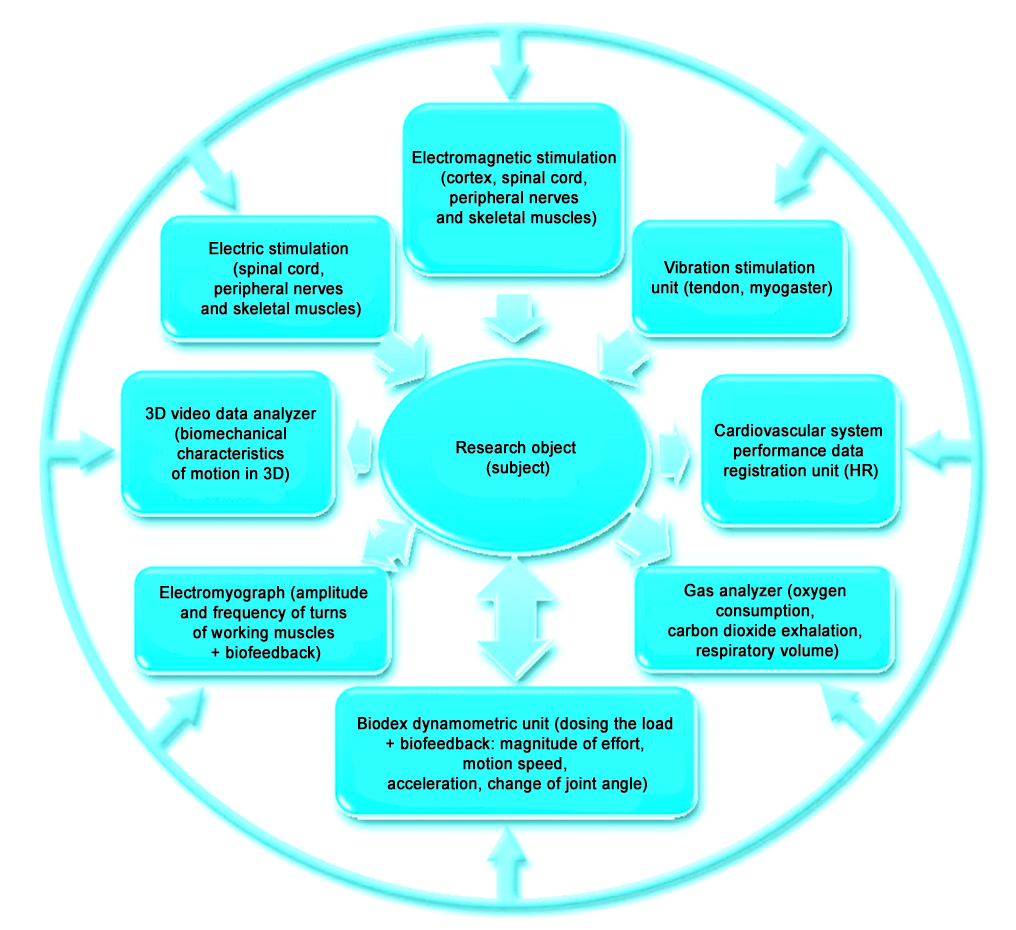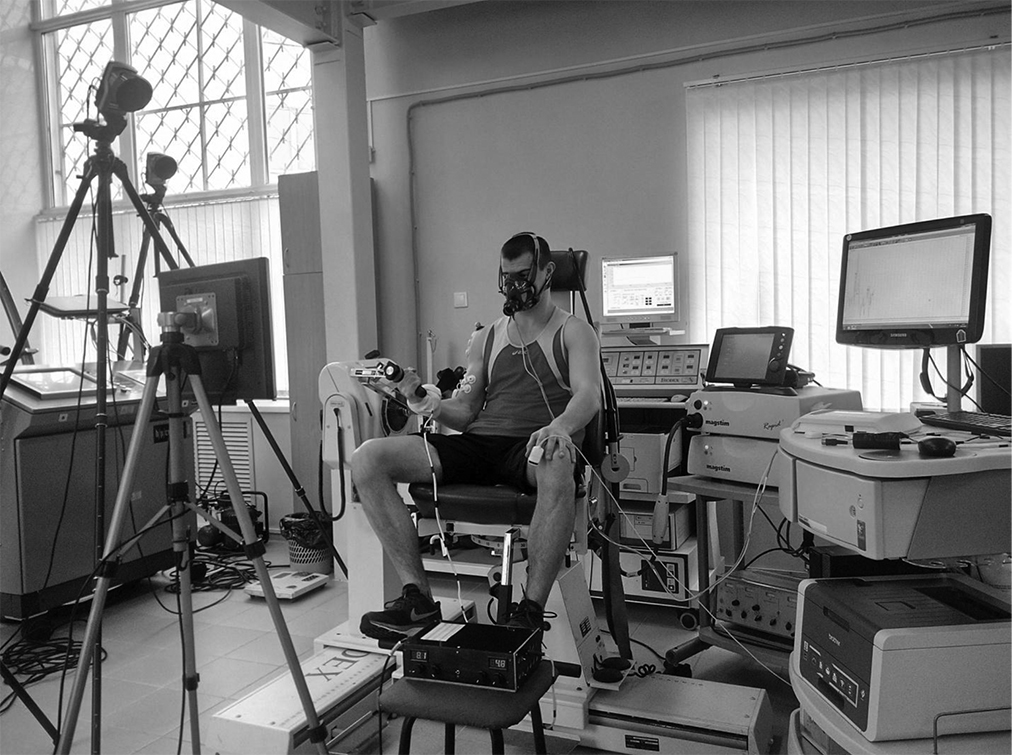"Mioboost" system application to improve athletic motor skills
Фотографии:
ˑ:
Associate Professor, PhD V.N. Shlyakhtov
Velikie Luki State Academy of Physical Culture and Sports, Velikie Luki
Keywords: computerized system, muscles, strength abilities, stimulating effects.
Introduction. Training effect of various strength training programs is determined not only by changes in the muscular system itself, but also by the dynamics of parameters reflecting the functional state of the other body systems. Complex analyses of strength training effects traditionally describe changes in the cardiovascular and respiratory systems in their anatomical aspect. In our opinion, this approach is inadequate, as changes of the said systems’ parameters are not linked to each (particular) performed motor action’s coordination structure. It is more expedient to analyse autonomic changes together with the coordination structure of movement from the standpoint of the theory of functional systems developed by P.K. Anokhin (1973). In this case, the analysis of autonomic changes during a single movement should be based on the functional system’s parameters in this performed motor action.
To achieve this goal, the training system should provide simultaneous (synchronous) recording of the main characteristics of muscle contraction; dynamic and kinematic parameters of the performed motor action; indicators reflecting the state of cardiovascular, respiratory and musculoskeletal systems.
In our opinion, the effectiveness of training using the system can be enhanced by equipping the machine with a unit capable of providing stimulation (electrical, electromagnetic, vibrational, etc) of the motor system of the training person while exercising on the machine.
Objective of the research was to develop and experimentally prove the effectiveness of using “MioBoost” training system for the development of athletes’ strength abilities.
Research method and organization. Together with experts from the Research Institute of Sports and Physical Culture we have created “MioBoost” Computerized System. It includes the following units: dynamometric unit; electromyograph; video data analyzer; gas analyzer; cardiovascular system performance data registration unit; electric stimulator; electromagnetic stimulator; and vibration stimulator units (Figure 1).
The performance stimulation units give the means to activate different segments of the spinal cord, movement control zones of the brain, peripheral nerves and skeletal muscles. All units of the Computerized System are interconnected that gives the means to track, on a real-time basis, the functional changes, the dynamic and kinematic performance parameters in every motor action.

Figure 1. Block diagram of the computerized system
Results and discussion. Educators of the Velikie Luki State Academy of Physical Culture and Sports [2] carried out a number of experiments using the described above system. The results indicated the effectiveness of the system for the development of strength abilities of athletes. Figure 2 shows a general view of an experimental study using the “MioBoost” Computerized System.

Figure 2. General view of the study using the “MioBoost” Computerized System
An advantage of this approach is that a strength exercise is performed against the background of certain external stimulating effects on various body structures of the training person. A stimulating effect on particular tissues, organs and human body systems while exercising on the machine can be aimed at the activation of the body physiological reserves on the one hand, and on the other – at a purposeful control of the performed motor action. External effects on the human body for the purpose of physiological functions activation can also be performed in a state of relative muscular rest. In this case, changes of physiological parameters will not be associated with the specifics of the coordination structure of a power motor action; furthermore, a stimulation session takes certain time that should be additionally integrated into the training process. The stimulating effect while exercising on the machine does not require any additional time, and the functional changes caused by it are organically integrated into the coordination pattern of the power motor action.
Conclusion. Equipping the machines with stimulating units is by no means the only possible way of improving the effectiveness of strength training using simulators. Achievements of scientific and technological progress, new knowledge in the field of physiology and biochemistry of exercise offer opportunities for creation of more technologically advanced fitness devices and development of more effective training programs to increase strength abilities of athletes.
Fully automated training systems organizing the training process on a fundamentally different basis may appear in the nearest future as a result of new fitness devices developed [3]. According to these authors, in the future fitness machines will be developed in three ways: emergence of new types of actuation systems allowing special kinds of muscle contraction; development and use of new types of sensors; improvement of the algorithms of the training process control in the automatic mode.
References
- Anokhin P.K. Printsipialnye voprosy obshchey teorii funktsionalnykh sistem [Fundamental questions of general theory of functional systems]. Printsipy sistemnoy organizatsii funktsiy [Principles of system organization of functions]. Moscow: Nauka publ., 1973, pp. 5-61.
- Belyaev A.G. Vliyanie magnitnoy stimulyatsii na silovye vozmozhnosti skeletnykh myshts. Avtoref. dis. kand. biol. nauk [Effect of magnetic stimulation on skeletal muscle strength potential. PhD diss. abstract]. Smolensk, 2015, 23 p.
- Netreba A.I., Vinogradova O.L., Orlov O.I. Evolyutsiya trenazhernykh ustroystv [Evolution of fitness machines]. Sport science. Moscow: Magistr-Press publ., 2011, pp. 413-422.
Corresponding author: shlyahtov@inbox.ru
Abstract
Efforts to improve the existing training simulator systems and design new equipment based on the new knowledge generated by the modern science and technology are considered among the key ways to improve athletic motor skills. It is a common knowledge that efficiency of the training process using a training simulator may be increased by additional electric/ vibration etc. stimulation units for the trainee’s physicality stimulation prior to the exercises on the training simulator. With this purpose we have designed “MioBoost” Computerized System that includes the following units: dynamometric unit; electromyograph; video data analyzer; gas analyzer; cardiovascular system performance data registration unit; electric stimulator; electromagnetic stimulator; and vibration stimulator units. The performance stimulation units give the means to activate different segments of the spinal cord, movement control zones of the brain, peripheral nerves and skeletal muscles in the exercise performance process. All units of the Computerized System are interconnected that gives the means to track, on a real-time basis, the dynamic and kinematic performance parameters in every motor action. The Computerized System was applied to perform the experimental study that demonstrated its benefits for strength development in an athletic training process.



